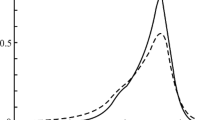Abstract
The effect that the molecular weight of oligoethylene adipate exerts on the properties of urethane-containing elastomers is studied. Three oligoethylene adipates have been obtained by means of adipic acid and ethylene glycol polycondensation. Based on these polyesters, as well as isophorone diisocyanate and aromatic diamine 3,3'-dichloro-4,4'-diaminodiphenylmethane, three polyurethane ureas are obtained. The deformation and strength properties of these elastomers have been studied.






Similar content being viewed by others
REFERENCES
H. Sarkhosh, M. Nourany, F. Noormohammadi, H. A. Ranjbar, M. Zakizadeh, and M. Javadzadeh, “Development of a semi-crystalline hybrid polyurethane nanocomposites for hMSCs cell culture and evaluation of body-temperature shape memory performance and isothermal crystallization kinetics,” J. Polym. Res. 28, 1–14 (2021).
A. Nissenbaum, I. Greenfeld, and H. D. Wagner, “Shape memory polyurethane-amorphous molecular mechanism during fixation and recovery,” Polymer 190, 122226 (2020).
A. Slobodinyuk, V. Strelnikov, V. Y. Senichev, and D. Slobodinyuk, “Preparation, structure and properties of urethane-containing elastomers based on epoxy terminal oligomers,” Polymers 14, 524 (2022).
N. V. Gama, A. Ferreira, and A. Barros-Timmons, “Polyurethane foams: past, present, and future,” Materials 11, 1841 (2018).
J. Herzberger, J. M. Sirrine, C. B. Williams, and T. E. Long, “Polymer design for 3D printing elastomers: recent advances in structure, properties, and printing,” Prog. Polym. Sci. 97, 101144 (2019).
S. K. Desai, S. Bera, and D. Mondal, “Multifaceted synthesis, properties and applications of polyurethanes and its composites,” Curr. Org. Chem. 23, 361–389 (2019).
V. V. Tereshatov, M. A. Makarova, V. Y. Senichev, E. R. Volkova, Z. A. Vnutskikh, and A. I. Slobodinyuk, “The role of the soft phase in the hardening effect and the rate dependence of the ultimate physico-mechanical properties of urethane-containing segmented elastomers,” Colloid Polym. Sci. 293, 153–164 (2015).
A. Slobodinyuk, V. Strelnikov, D. Kiselkov, and D. Slobodinyuk, “Synthesis of oligotetramethylene oxides with terminal amino groups as curing agents for an epoxyurethane oligomer,” Z. Naturforsch. 76, 511–515.
B. J. Rashmi, D. Rusu, K. Prashantha, M. F. Lacrampe, and P. Krawczak, “Development of bio-based thermoplastic polyurethanes formulations using corn-derived chain extender for reactive rotational molding,” Express Polym. Lett. 7, 852–862 (2013).
S. Weinberger, A. Pellis, J. W. Comerford, T. J. Farmer, and G. M. Guebitz, “Efficient physisorption of candida antarctica lipase b on polypropylene beads and application for polyester synthesis,” Catalysts 8, 369 (2018).
Y. Assem, H. A. Mohamed, R. Said, and A. El-Masry, “Preparation of amphiphilic block copolymers (polyethylene adipate-blockpolyethylene glycol) and its application in rotogravure ink formulations,” Pigm. Resin Technol. 47, 415–423 (2018).
G. Socrates, Infrared and Raman Characteristic Group Frequencies: Tables and Charts (Wiley, 2004).
V. V. Tereshatov, M. A. Makarova, V. Y. Senichev, and A. I. Slobodinyuk, “Interrelationship between ultimate mechanical properties of variously structured polyurethanes and poly (urethane urea) s and stretching rate thereof,” Colloid Polym. Sci. 290, 641–651 (2012).
Funding
This work was performed in the scope of a state order (state registration no. 122011900165-2) and the project “Chemical Products in Subsurface Use” of the Perm Scientific and Educational Center “Rational Subsurface Use” using the equipment of the Center for Collective Use “Studies on Materials and Substances” of the Perm Federal Research Center of the Ural Branch of the Russian Academy of Sciences.
Author information
Authors and Affiliations
Corresponding author
Ethics declarations
The authors of this work declare that they have no conflicts of interest.
Additional information
Translated by O. Polyakov
Rights and permissions
About this article
Cite this article
Slobodinyuk, A.I., Senichev, V.Y., Perepada, M.V. et al. Structure and Properties of Urethane-Containing Elastomers Based on Adipic Acid Polyester and Ethylene Glycol, Isophorone Disocyanate, and Aromatic Diamine. Polym. Sci. Ser. D 16, 576–581 (2023). https://doi.org/10.1134/S1995421223030413
Received:
Revised:
Accepted:
Published:
Issue Date:
DOI: https://doi.org/10.1134/S1995421223030413



